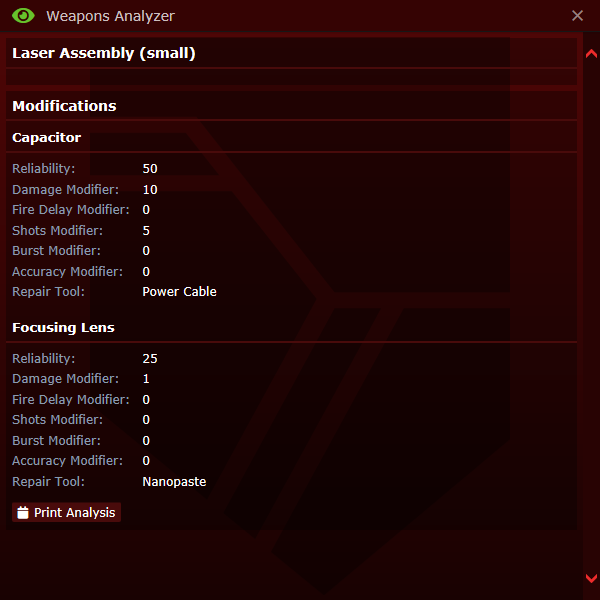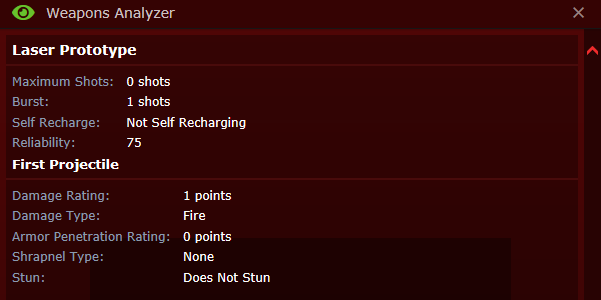Guide to Modular Weaponry
A portion of the job of research is referred to as Modular Weaponry. it is the act of combining parts together to create a prototype, which can then be tested, upgraded or trashed. normally at the end, it's given to security or used by research for expeditions. Just remember if you're giving a prototype to security, Get command authorization first, or it's technically breaking regulation four.
Guide to creating your first prototype
To start construction on a prototype, the first thing you need to do is obtain a weapons analyzer.
- Print a weapons analyzer board from the circuit imprinter
- Steel
- Create a machine blueprint
- Left click it
- Add cables
- The board
- 1 capacitor
- 2 scanning modules
- 1 console screen
- Screwdriver.
You now have the amateur weapon-smith's dream. You can put in an assembly and add components, or even analyze a normal weapon like a pistol, or a screwdriver.
Once your have your analyzer, you'll want to pick one item from each category, plus an assembly, and add them all to the device. The order of additions doesn't matter, but you should normally start with your assembly, add your capacitor, frills, lens and modulator. whenever you add the modulator, it finalizes the weapon. once your weapon is finished, it'll make a different noise, and change the interface on the analyzer.
During and after finalization, there are two screens in the analyzer. You have your assembly screen, and your finalized product screen. Both screens provide some valuable information
Assembly
During assembly, every single component has eight different stats. These stats mirror the actual stats of the finalized prototype.
- Reliability: The finalized number is the chance the weapon has to explode in your hands when fired. Items like capacitors and lenses up this, and items like stocks and bayonets lower it.
- Damage modifier: Higher number equals higher damage.
- Fire delay modifier: Higher number equals longer delay between shots.
- Number of shots modifier: This is normally only modified by a capacitor. The better your capacity means the more shots you can fire without having to recharge your gun.
- Burst modifier: The burst modifier indicates how many shots its going to fire in one press
- Accuracy modifier: Higher number equals better accuracy. every gun has a chance to miss your shot when it connects with someone, higher accuracy means less of a chance for that to happen. things like stocks up it, and a gatling rotator lowers it massively.
- Repair tool: The tool required to repair the component.
Prototype
Once your prototype has been finalized by adding the modulator, the screen changes to include the data from the assembly screen, plus 11 extra sections. These sections are the following
- Maximum Shots: Lists the amount of shots stored in one charge.
- Burst: How many projectiles it shoots in a single burst.
- Self Recharge: If the gun is self-recharging.
- Recharge Time: How long it takes to recharge.
- Reliability: The likelihood the gun will malfunction from over-usage. This is identifiable sometimes by a red message saying the capacitor overloads. if you keep firing a low reliability gun, it will explode.
- Projectiles estimated damage rating: The damage of the projectile.
- Projectiles Damage Type: The type of damage of the projectile.
- Projectiles Estimated Armor Penetration Rating: The armor penetration rating of the projectile.
- Projectiles armor damage type: The type of damage inflicted on armor by the projectile fired.
- Projectiles Shrapnel Type: If it fires shrapnel. if it does, indicates what kind
- Stun: Whether or not it stuns
Assemblies
Small Laser Assembly (2000 steel) Medium Laser Assembly (4000 steel) Large Laser Assembly (8000 steel)
Barrels
Reinforced Barrel (3000 steel) Nano-Reinforced barrel (5000 steel)
Capacitors
Capacitor (1000 steel) Starch Capacitor (1000 steel) Reinforced Capacitor (4000 steel) Uranium-Enriched Capacitor (4000 steel, 1000 uranium) Terranium-Enriched Capacitor (4000 steel, 1000 glass, 500 uranium) Phoron-Enriched Capacitor (4000 steel, 3000 solid phoron, 500 uranium) Bluespace-Enriched Capacitor (4000 steel, 3000 solid phoron, 500 uranium, 1000 diamond)
Capacitor addition
Surge protector (5000 steel, 1000 glass) Pulser (5000 steel, 1000 glass) Auxiliary Capacitor (5000 steel, 1000 glass) Capacitor Overcharge (5000 steel, 1000 glass) Gatling Rotater (750 steel, 3000 glass, 2000 solid phoron, 2000 silver, 1000 diamond)
Lenses
Focusing Lens (500 steel, 2000 glass) Splitter Lens (750 steel, 2000 glass) Precise Lens (750 steel, 2000 glass) Reinforced Lens (2000 steel, 1000 glass)
Barrel addition
Energy Suppressor (2000 steel) Telescopic Sight (1000 steel, 500 glass) Exhaust Venting (3000 steel) Stability Stock (5000 steel) Improved Stock (3000 steel) Bayonet (3000 steel) Energy Bayonet (3000 steel, 500 silver, 500 solid phoron) Enhanced Grip (3000 steel) Enhanced Grip MK2 (5000 steel)
Modulators
TASER Modulator (4000 steel) Tesla Modulator (4000 steel, 1000 silver, 2000 solid phoron) Ion Modulator (750 steel, 500 glass, 2000 solid phoron) Floral Somatomodulator (1000 steel, 250 glass, 250 uranium) Betaray Modulator (1000 steel, 250 glass, 250 uranium) Arodentia Modulator (2000 steel, 1000 glass, 500 uranium) Red Team Modulator (2000 steel) Blue Team Modulator (2000 steel) Omni Team Modulator (2000 steel) Practice Beam Modulator (2000 steel) Decloner Modulator (5000 steel, 1000 glass, 3000 solid phoron) Dart modulator (5000 steel, 1000 glass, 3000 solid phoron) Blaster-Bolt Modulator (8000 steel, 2000 glass, 6000 solid phoron) Laser Modulator (750 steel, 500 glass, 1000 solid phoron) Phoron Bolt Modulator (2500 steel, 1000 glass, 2000 solid phoron) Energy Net Modulator(5000 steel, 1000 glass, 3000 solid phoron)
Research Department
| |
| Head of department | Research Director |
| Personnel | Scientist - Xenobiologist - Xenoarcheologist - Roboticist |
| Useful guides | Guide to Research and Development - Guide to Xenobiology - Guide to Xenobotany - Guide to Xenoarchaeology - Integrated Electronics - Guide to Telescience - Guide to Modular Weaponry |

